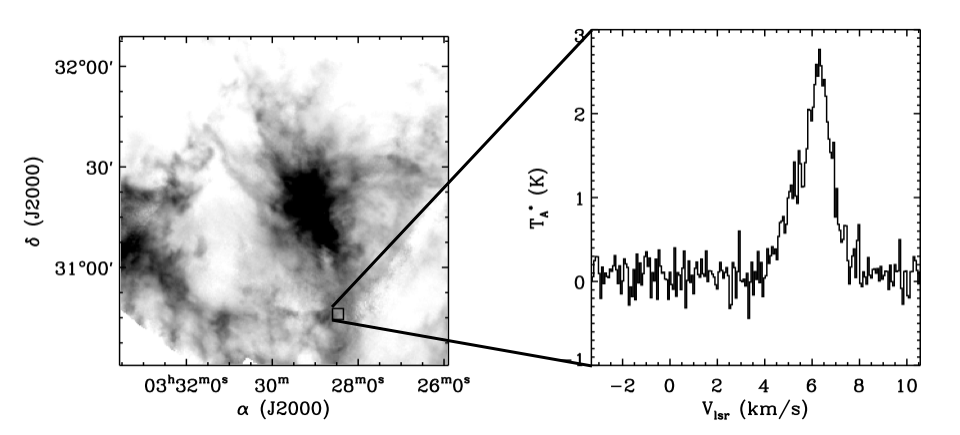GMC readings
This post presents a quick introduction to the relevant parts of the literature to give a crash course on molecular cloud properties, a mainstay of my research.
Physics and Observational Considerations
Astronomers pay attention to Molecular Clouds (MCs) since these complexes of molecular gas host all contemporary star formation. Molecular gas is defined by the chemical state of hydrogen being . However, at the typical temperatures of these clouds, such the molecular hydrogen emits no radiation. Thus, we must use tracers to identify this gas. There are many tracers available, but we focus on the emission of the CO molecule, which the usually the second-most-abundant molecule in the ISM after the . CO gives of radiation through rotational quantum mechanical transitions between rotational energy levels specified by the quantum number . The lowest energy rotational transition is which gives off radiation at . With , this transition is easily observed in most molecular clouds. We will use the shorthand CO(1-0) to indicate this particular radiation.
Of note, this is spectral line radiation which is observed with millimetre-wave telescopes such as the Nobeyama 45m, the IRAM 30m, or ALMA. These telescopes have excellent frequency resolution so that the centre and the width of the spectral line can be resolved, meaning that we can use the Doppler shift to measure how fast the cloud is moving towards us or away from as as well as the magnitude of the internal motions of the clouds. When these telescopes make maps of the sky, every position is actually a spectrum as depicted in the figure below.

Thus, we view the CO(1-0) maps of clouds as data cubes, where two of the dimensions are position on the sky and the last dimension is frequency. By knowing the distance to the cloud and using the Doppler relation, the cube can be transformed into a cube where two of the axes are position and the spectral axis becomes a velocity axis, making a position-position-velocity (PPV) cube. We then use these data to identify molecular clouds and characterize their properties.
Giant Molecular Clouds
We will usually be discussing Giant Molecular Clouds (GMCs). The term giant really means massive with my preferred qualifying divider between “ordinary” molecular clouds and “giant” clouds are clouds with mass . This is not well defined in the literature, but I prefer this boundary since it is very roughly the scale of cloud required to form the highest mass stars (O-stars).
The notion of GMCs became developed with the first extensive surveys of CO(1-0) emission from the Milky Way’s disk in the 1980s. Solomon et al. (1987) presented a foundational work in the study of molecular clouds. It is one of a few landmark studies to be published in the late 1980s, and I point to this particular study since the approaches used in this work are the most relevant for this ongoing line of research. This is a good article to read because it outlines both how the properties of molecular clouds are determined and the fiducial results.
In nearby galaxies, only the brightest emission is readily detected, meaning that we only see gas from GMCs when we make high resolution observations. Much of my PhD thesis work focused on GMC properties in nearby systems and this work plus that of my collaborators formed a major push in GMC properties in the mid-2000s. The summary of this work was best presented in Fukui & Kawamura (2010). This is an annual review article summarizing the properties of molecular clouds in nearby galaxies. This represents the consensus state-of-play pre-ALMA. ALMA has done a lot to change this game since it is significantly more sensitive than other observatories. It’s making beautiful maps that people like me don’t have time to analyze (check out the JVO archive).
The above work all relies on the ability to extract GMCs from PPV data cubes. Much thought has been invested in this particular problem, and Adam Leroy and I tried to build a definitive piece of software to do that. It was better than what existed at the time, but this is not a solved problem at all. The result was the package CPROPS, which has been upgraded almost entirely by Adam to cpropstoo. The details about how CPROPS works are in Rosolowsky & Leroy (2006).
Do GMCs exist?
No discussion of GMCs would be complete without appropriate caveats. GMCs are not like stars. For stars, we can assign material to a single star so stars are clearly discrete objects. What we call GMCs are part of a larger molecular medium with substantial diffuse emission surrounding the putative objects. This diffuse emission does not appear to participate in star formation in the same way as the denser material we want to associate with GMCs. Furthermore, GMCs likely have significant mass flux in and out of the clouds over their lifetime. Are GMCs well defined objects if they aren’t anywhere near an equilibrium state? However, GMCs appear distinct because of their significant self-gravitation, as pointed out long ago, a property which can distinguish between GMCs and other clouds of molecular gas quantitatively. It remains a matter of some debate here, but my personal view is that GMCs remain useful constructs to describe the structure of molecular gas in other galaxies. However, these GMCs are constantly changing and evolving and should always been thought of dynamically.
